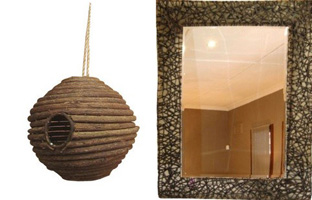![Galtang [Arcangelisia flava (l.) Merr] (left) and Tilob [Dicranopteris linearis (Burm. f.) Underw.] (right) (Image credit: DOST- Forest Products Research and Development Institute (DOST-FPRDI))](/images/stories/2017/img070618_vinesA.jpg) Forest vines are considered to be one of the best sources of raw materials for handicraft production. They are also excellent sources of materials for low-cost housing, food and beverages, clothing, medicine and other products in the rural areas.
Forest vines are considered to be one of the best sources of raw materials for handicraft production. They are also excellent sources of materials for low-cost housing, food and beverages, clothing, medicine and other products in the rural areas.
These herbaceous or woody plants have roots anchored to the ground and the rest of their bodies can climb without the help on tendrils and hooks. They cling to trees and other plants for mechanical support and position themselves to capture light. With their long yet flexible stems, forest vines are suitable for novelty hand-made items that are popular in markets for native products.
Forest vines are considerably abundant in the Philippine forests, making our country the second largest world producer of handicrafts, mainly baskets out of indigenous materials. However, the country’s handicraft industry is experiencing problem on export due to insufficient supply of raw materials and stiff competition from other handicraft producing countries such as China, Vietnam, Malaysia and Thailand.
Despite their promising use as raw materials for handcrafted items, forest vines are among the lesser studied non-timber forest products (NTFPs) in the country. NTFPs are also referred to as "minor forest products." Because of this, the forest vines industry is beset with problems and challenges. Among them is the lack of market information, inefficient extraction and processing technology, lack of raw material supply, and lack of capital to finance NTFP plantation development.
S&T Interventions
With funding from the Philippine Council for Agriculture, Aquatic and Natural Resources Research and Development of the Department of Science and Technology (DOST-PCAARRD), a program was developed to highlight the importance of forest vines in our country. Titled “Philippine Forest Vines for Handicraft and Furniture Industry,” this program is implemented by the DOST- Forest Products Research and Development Institute (DOST-FPRDI).
DOST-PCAARRD funded four projects implemented by DOST-FPRDI under the forest vines program:
1. Biological Studies of Economically Important Forest Vines in Camarines Sur and Albay Provinces
2. Treatability and Performance of Commercial Forest Woody Vines Using Chemical and Organic Preservatives
3. Evaluation of the Physical and Mechanical Properties of Economically Important Forest Woody Vines
4. Value Chain Assessment of Commercially Important Forest Vines
These projects aim to utilize non-commercial species of forest vines, promote sustainable management, develop nurseries and demo farms, improve harvesting technologies, and provide recommendations to the handicrafts and furniture industries for improvement in the supply chain.
 Extensive resource survey and inventory will be conducted to have actual data of forest vines in the wild. The supply chain of commercially important forest vines will also be mapped out. Moreover, physical and mechanical properties of economically important forest woody vines and appropriate preservation and treatment of these vines and its products will be studied.
Extensive resource survey and inventory will be conducted to have actual data of forest vines in the wild. The supply chain of commercially important forest vines will also be mapped out. Moreover, physical and mechanical properties of economically important forest woody vines and appropriate preservation and treatment of these vines and its products will be studied.
With the help of the technologies that will be developed, the furniture and handicrafts industries can be efficient and effective in producing raw materials and marketing their products made of forest woody vines.
By utilizing forest vines into various products, farmers and people living in the uplands can generate additional income and also increase our country’s exports for the handicraft industry.
Future Directions
Although forest vines are mainly used for making handicrafts and furniture, other novel and innovative products may be uncovered and developed. These S&T interventions can provide better opportunities to the various players in the industry
To date, DOST-PCAARRD is continuously working on addressing the challenges faced by the handicrafts industry to meet the high demands for forest vines products. With the projects under the “Philippine Forest Vines for Handicraft and Furniture Industry” program, we will be able to provide adequate supply of raw materials to various end-users and the industries while at the same, time conserving the resources. Promoting equitable access to opportunities in the utilization of the resources and promoting economic development in the rural areas can also be achieved. Lastly, the development of raw materials and resources can be institutionalized.
The results of these S&T interventions can put the forest vines industry in the limelight, providing opportunities for more researchers to study forest vines while highlighting its economic importance.
